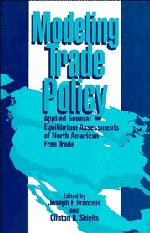Book contents
- Frontmatter
- Contents
- List of Contributors
- Dedication
- Part I Introduction
- Part II Multisector Models
- Part III Sector-Focused Models
- 6 Agriculture in the Mexico-U.S. Free Trade Agreement: A General Equilibrium Analysis
- 7 Wage Changes in a U.S.-Mexico Free Trade Area: Migration Versus Stolper-Samuelson Effects
- 8 The Auto Industry and the North American Free Trade Agreement
- 9 Trade Liberalization in Quota-Restricted Items: The United States and Mexico in Textiles and Steel
- Part IV Dynamic Models
- Index
6 - Agriculture in the Mexico-U.S. Free Trade Agreement: A General Equilibrium Analysis
Published online by Cambridge University Press: 25 March 2010
- Frontmatter
- Contents
- List of Contributors
- Dedication
- Part I Introduction
- Part II Multisector Models
- Part III Sector-Focused Models
- 6 Agriculture in the Mexico-U.S. Free Trade Agreement: A General Equilibrium Analysis
- 7 Wage Changes in a U.S.-Mexico Free Trade Area: Migration Versus Stolper-Samuelson Effects
- 8 The Auto Industry and the North American Free Trade Agreement
- 9 Trade Liberalization in Quota-Restricted Items: The United States and Mexico in Textiles and Steel
- Part IV Dynamic Models
- Index
Summary
Introduction
Agriculture contributes less than 8 percent of Mexico's GDP. Nevertheless, when in June 1990 Presidents Salinas and Bush announced negotiations on a free trade agreement (FTA) between Mexico and the United States, it was clear that agriculture would be a major stumbling block. At stake is much more than the efficiency gains that liberalizing agriculture, particularly maize production, would bring to Mexico, substantial as we find them to be. Maize protection is Mexico's de facto rural employment and antipoverty program, so distributional concerns complicate the liberalization process. Further complications arise because, while high maize prices almost certainly contribute to, rather than alleviate, poverty, rapid liberalization would increase poverty during transition.
This paper focuses on the distributional effects of liberalizing maize in Mexico, the policies that can be put in place to alleviate them, and the incentive problems that would be caused by such policies. Our results, however, are of much wider interest than the FTA negotiations themselves. Agriculture has been a major stumbling block in trade negotiations everywhere, having always been excluded from GATT negotiations until the recent Uruguay round, which almost collapsed because of it. In many cases the reasons are similar to the ones discussed in this paper.
Transitional problems like the ones analyzed in this paper are likely to arise in most major economic reforms. In particular, we focus on the implications for policy design of the absence of well-functioning capital markets, on the welfare costs of reforming only gradually, on the incentive problems created by trade adjustment policies, and on the redistributive aspects of policy reform in the presence of realistic limits on the array of intervention instruments available to the Government.
- Type
- Chapter
- Information
- Modeling Trade PolicyApplied General Equilibrium Assessments of North American Free Trade, pp. 151 - 194Publisher: Cambridge University PressPrint publication year: 1994
- 2
- Cited by



